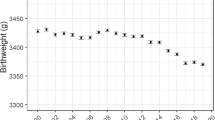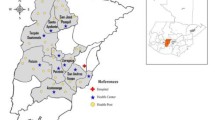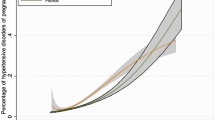Abstract
Background
Maternal characteristics such as age, parity, smoking status, pre-pregnancy weight and pregnancy weight gain have changed in many industrialized countries in recent years. Many of these changes have not been adequately described at a population level. The purpose of this study was to describe recent trends in selected maternal characteristics in Nova Scotia.
Methods
Data from a population-based perinatal database were used to examine changes in maternal age, parity, smoking, pre-pregnancy weight, delivery weight and pregnancy weight gain among all deliveries between 1988 and 2001.
Results
The proportion of deliveries to women ≥35 years increased by 84% over the study period from 7.0% in 1988–1991 to 12.9% in 1998–2000, while deliveries to women ≥40 years increased by more than 100%. The number of nulliparous women ≥35 years also increased significantly. The overall prevalence of smoking decreased from 32.7% in 1988–1991 to 25.1% in 1998–2001, however the prevalence of smoking among women ≤20 years did not change over the study period and was almost 50%. The proportion of women with a pre-pregnancy weight of ≥90 kilograms (kg) increased by 165% from 4.1% in 1988–1991 to 10.7% in 1998–2001. The proportion of women with pregnancy weight gain of ≤7 kg and ≥18 kg increased by 37% and 13%, respectively.
Conclusion
Dramatic changes have occurred in several important maternal characteristics and there is evidence of ongoing change. Continuation of these trends is likely to impact on future obstetric practice and perinatal health.
Résmé
Contexte
Les caractéristiques maternelles comme l’âge, le rang des naissances, l’usage du tabac, le poids avant la grossesse et le gain de poids durant la grossesse ont changé dans de nombreux pays industrialisés ces dernières années. Beaucoup de ces changements n’ont pas été convenablement décrits pour l’ensemble de la population. Notre étude visait donc à décrire les tendances récentes de certaines caractéristiques maternelles en Nouvelle-Écosse.
Méthode
À partir de données extraites d’une base de données périnatales représentatives, nous avons examiné l’évolution de l’âge des mères, du rang des naissances, du tabagisme, du poids avant la grossesse, du poids à l’accouchement et du gain de poids durant la grossesse pour tous les accouchements survenus entre 1988 et 2001.
Résultats
La proportion de femmes de plus de 35 ans ayant accouché a augmenté de 84 % sur la période de l’étude, passant de 7,0 % en 1988–1991 à 12,9 % en 1998–2000, et la proportion des femmes de plus de 40 ans ayant accouché a augmenté de plus de 100 %. Le nombre de nullipares de plus de 35 ans a également augmenté. La prévalence globale du tabagisme a diminué, passant de 32,7 % en 1988–1991 à 25,1 % en 1998–2001, mais elle est restée inchangée chez les femmes de moins de 20 ans, à près de 50 %, pendant cette période. La proportion des femmes pesant plus de 90 kg avant la grossesse a augmenté de 165 %, passant de 4,1 % en 1988–1991 à 10,7 % en 1998–2001. La proportion des femmes ayant pris moins de 7 kg ou plus de 18 kg durant la grossesse a augmenté de 37 % et de 13 %, respectivement.
Conclusion
Plusieurs caractéristiques maternelles importantes ont changé de façon spectaculaire, et les données semblent faire état d’une évolution continue. Si ces tendances se maintiennent, elles pourraient avoir un effet sur la pratique future de l’obstétrique et sur la santé périnatale.
Similar content being viewed by others
References
Ford D, Nault F. Changing fertility patterns, 1974 to 1994. Health Reports 1996;8:39–46.
Mathews TJ, Hamilton BE. Mean age of mother, 1970–2000. National Vital Statistics Reports; Vol 51, No 1. Hyattsville, Maryland: National Center for Health Statistics, 2002.
Health Canada. Canadian Perinatal Health Report, 2003. Ottawa: Minister of Public Works and Government Services Canada, 2003.
Martin JA, Hamilton BE, Ventura SJ, Menacker F, Park MM. Births: Final Data for 2000. National Vital Statistics Reports; Vol 50, No 5. Hyattsville, Maryland: National Center for Health Statistics, 2002.
Dodds L. Prevalence of smoking among pregnant women in Nova Scotia from 1988 to 1992. CMAJ 1995;152:185–90.
Stewart PJ, Potter J, Dulberg C, Niday P, Nimrod C, Tawagi G. Change in smoking prevalence among pregnant women 1982–93. CMAJ 1995;86:37–41.
Ebrahim SH, Floyd RL, Merritt RK, Decoufle P, Holtzman D. Trends in pregnancy-related smoking rates in the United States, 1987–1996. JAMA 2000;283:361–66.
Mathews TJ. Smoking during pregnancy in the 1990s. National Vital Statistics Reports; Vol 49, No 7. Hyattsville, Maryland: National Center for Health Statistics, 2001.
Cnattingius S, Lambe M. Trends in smoking and overweight during pregnancy: Prevalence, risks of pregnancy complications, and adverse pregnancy outcomes. Seminars in Perinatology 2002;26:286–95.
Jaakkola N, Jaakkola MS, Gissler M, Jaakkola JJK. Smoking during pregnancy in Finland: Determinants and trends, 1987–1997. Am J Public Health 2001;91:284–86.
Torrance GM, Hooper MD, Reeder BA. Trends in overweight and obesity among adults in Canada (1970–1992): Evidence from national surveys using measured height and weight. Int J Obesity 2002;26:797–804.
Flegal KM, Carroll MD, Ogden CL, Johnson CL. Prevalence and trends in obesity among US adults, 1999–2000. JAMA 2002;288:1723–27.
Institute of Medicine, Subcommittee on Nutritional Status and Weight Gain During Pregnancy. Nutrition During Pregnancy: Weight Gain, Part II: Nutrient Supplements. Washington, DC: National Academy Press, 1990.
Lu GC, Rouse DJ, DuBard M, Cliver S, Kimberlin D, Hauth JC. The effect of the increasing prevalence of maternal obesity on perinatal morbidity. Am J Obstet Gynecol 2001;185:845–49.
Ehrenberg HM, Dierker L, Milluzzi C, Mercer BM. Prevalence of maternal obesity in an urban center. Am J Obstet Gynecol 2002;187:1189–93.
Kramer MS, Morin I, Yang H, Platt RW, Usher R, McNamara H, et al. Why are babies getting bigger? Temporal trends in fetal growth and its determinants. J Pediatrics 2002;141:538–42.
Cnattingius S, Bergstrom R, Lipworth L, Kramer MS. Prepregnancy weight and the risk of adverse pregnancy outcomes. N Engl J Med 1998;338:147–52.
Abrams B, Altman SL, Pickett KE. Pregnancy weight gain: Still controversial. Am J Clin Nutr 2000;71(suppl):1233S–1241S.
Parrish KM, Holt VL, Easterling TR, Connell FA, LoGerfo JP. Effect of changes in maternal age, parity, and birth weight distribution on primary cesarean delivery rates. JAMA 1994;271:443–47.
Baeten JM, Bukusi EA, Lambe M. Pregnancy complications and outcomes among overweight and obese nulliparous women. Am J Public Health 2001;91:436–40.
Edwards LE, Hellerstedt WL, Alton IR, Story M, Himes JH. Pregnancy complications and birth outcomes in obese and normal-weight women: Effects of gestational weight change. Obstetrics & Gynecol 1996;87:389–94.
Shepard MJ, Saftlas AF, Leo-Summers L, Bracken MB. Maternal anthropometric factors and risk of primary cesarean delivery. Am J Public Health 1998;88:1534–38.
Young TK, Woodmansee B. Factors that are associated with cesarean delivery in a large private practice: The importance of prepregnancy body mass index and weight gain. Am J Obstet Gynecol 2002;187:312–20.
Joseph KS, Young DC, Dodds L, O’Connell CM, Allen VM, Chandra S, et al. The contribution of maternal characteristics and obstetric practice to recent increases in primary cesarean delivery. Obstetrics & Gynecol 2003;102:791–800.
Fair M, Cyr M, Allen AC, Wen SW, Guyon G, MacDonald RC. Validation study for a record linkage of births and infant deaths in Canada. Statistics Canada, Catalogue No. 84F0013XIE, 1999.
Fair M, Cyr M, Allen AC, Wen SW, Guyon G, MacDonald RC. An assessment of the validity of a computer system probabilistic record linkage of birth and infant death records in Canada. Chron Dis Can 2000;21:8–13.
Health Canada. Nutrition for a Healthy Pregnancy: National Guidelines for the Childbearing Years. Ottawa: Minister of Public Works and Government Services Canada, 1999.
Resnik R. The “elderly primigravida”. N Engl J Med 1990;322:693–94.
Astolfi P, Zonta LA. Delayed maternity and risk at delivery. Paediatric and Perinatal Epidemiol 2002;16:67–72.
Tough SC, Newburn-Cook C, Johnston DW, Svenson LW, Rose S, Belik J. Delayed childbear-ing and its impact on population rate changes in lower birth weight, multiple birth and preterm delivery. Pediatrics 2002;109:399–403.
Fretts RC, Schmittdiel J, McLean FH, Usher RH, Goldman MB. Increased maternal age and the risk of fetal death. N Engl J Med 1995;333:953–57.
Bianco A, Stone J, Lynch L, Lapinski R, Berkowitz G, Berkowitz RL. Pregnancy outcome at age 40 and older. Obstetrics & Gynecol 1996;87:917–22.
Hook EB. Rates of chromosome abnormalities at different maternal ages. Obstetrics & Gynecol 1981;58:282–85.
Liu S, Joseph KS, Wen SW, Kramer MS, Marcoux S, Ohlsson A, et al. Secular trends in congenital anomaly-related fetal and infant mortality in Canada, 1985–1996. Am J Med Genetics 2001;104:7–13.
Liu S, Joseph KS, Kramer MS, Allen AC, Sauve R, Rusen ID, et al. Relationship of prenatal diagnosis and pregnancy termination to overall infant mortality in Canada. JAMA 2002;298:1561–67.
Odegard RA, Vatten LJ, Nilsen ST, Salvesen KA, Austgulen R. Risk factors and clinical manifestations of pre-eclampsia. Br J Obstet Gynecol 2000;107:1410–16.
Pollack H, Lantz PM, Frohna JG. Maternal smoking and adverse birth outcomes among singletons and twins. Am J Public Health 2000;91:395–400.
Poulin C, Wilbur B. Nova Scotia Student Drug Use 2002–Technical Report. Province of Nova Scotia, 2002.
Health Canada, 2002. Tobacco Control Programme. Supplementary Tables, CTUMS Wave 1. https://doi.org/www.hc-sc.gc.ca/hecssesc/tobacco/research/ctums/2002/wave1_2002_supptables_ eng.pdf.
Poulin C, Graham L. The association between substance use, unplanned sexual intercourse and other sexual behaviours among adolescent students. Addiction 2001;96:607–21.
Flanagan P, Kokotailo P. Adolescent pregnancy and substance use. Clinical Perinatology 1999;26:185–200.
Caulfield LE, Witter FR, Stoltzfus RJ. Determinants of gestational weight gain outside the recommended ranges among black and white women. Obstetrics & Gynecol 1996;87:760–66.
Rooney BL, Schauberger CW. Excess pregnancy weight gain and long-term obesity: One decade later. Obstetrics & Gynecol 2002;100:245–52.
Author information
Authors and Affiliations
Corresponding author
Rights and permissions
About this article
Cite this article
Fell, D.B., Joseph, K.S., Dodds, L. et al. Changes in Maternal Characteristics in Nova Scotia, Canada from 1988 to 2001. Can J Public Health 96, 234–238 (2005). https://doi.org/10.1007/BF03403698
Received:
Accepted:
Published:
Issue Date:
DOI: https://doi.org/10.1007/BF03403698




